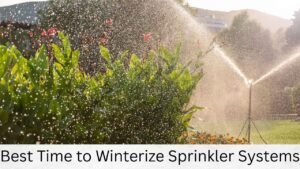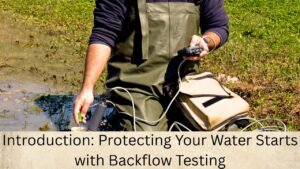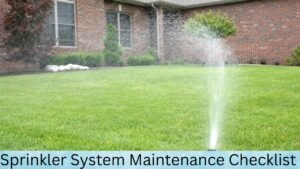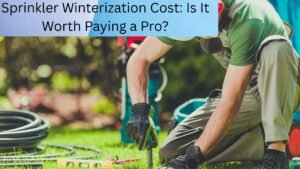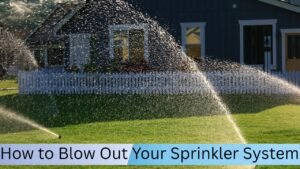Tired of uneven watering or brown patches on your lawn? Regular sprinkler system maintenance is the key to a healthy, lush yard. From cleaning heads and checking valves to adjusting controllers and monitoring water usage, proper upkeep keeps your lawn green, prevents costly repairs, and saves water. This guide walks you through all the essential sprinkler system maintenance steps so your irrigation system runs efficiently year-round.
Understanding Your Sprinkler System
Selecting the right sprinkler type is key to an efficient irrigation system. Different sprinklers—like rotary, fixed, or drip—serve specific watering needs and landscapes. Sprinkler Warehouse explains in their YouTube video below: “Types of Sprinklers” (Apr 27, 2022) how each type works and where it performs best. Knowing these options helps homeowners optimize coverage and maintain a healthy, well-watered lawn.
So, what exactly are you working with? Let’s break it down:
Types of Sprinkler Systems
- In-Ground Sprinklers: These are the crème de la crème of sprinkler systems. They pop up only when needed and retract out of sight when done. Perfect for large yards, but beware—installation can be pricey and repairs a bit of a hassle.
- Pop-Up Sprinklers: A subtype of in-ground systems, these are great for smaller areas and offer even coverage. They’re fantastic if you’re a fan of neat, no-show sprinklers. Just keep an eye out for occasional clogs.
- Rotary Sprinklers: These guys spin around and cover a broad area. They’re ideal for those weirdly shaped lawns where a fixed pattern won’t do. But, they might not be the best for small patches of grass.
- Fixed Sprinklers: They spray in a fixed pattern, making them super precise. Great for small areas or flower beds, but they can be a bit of a pain to adjust.
Key Components
Let’s take a peek under the hood:
- Controller: This is your system’s brain, managing watering schedules. Smart controllers are the way to go—they adjust based on weather forecasts and can be controlled from your smartphone.
- Valves: They regulate the flow of water. If your system seems uneven, valves might be the culprit.
- Pipes: These carry water to your sprinklers. Regular checks can prevent annoying leaks and costly repairs.
- Heads: These are the parts that actually spray the water. Keeping them clean and properly aligned ensures your lawn gets an even soak.
Step-by-Step Sprinkler System Maintenance Guide
Keeping your system running smoothly is like giving it a regular check-up. Here’s what you need to do:
Spring
- Winterization: Before you get started, remove any remaining water to prevent freezing damage.
- Head Adjustments: Inspect and align sprinkler heads for full coverage. If they’re spraying in weird directions, it’s time for a tweak.
- Leak Checks: Look for leaks in pipes and valves. A little drip now can lead to a big problem later.
Summer
- Regular Inspections: Check your system’s performance. Adjust settings based on the weather and how your lawn is holding up.
- Controller Programming: Make sure it matches your lawn’s needs. Hot weather might mean more frequent watering.
- Water Usage Monitoring: Keep an eye on how much water you’re using. Adjust as necessary to avoid wastage.
Fall
- Winterization Preparation: Before the frost hits, blow out the system to remove any water remaining in the pipes.
- System Blow-Out: Use compressed air to clear out the lines. It sounds like a lot of work, but it prevents freezing and cracking.
- Troubleshooting: Address any issues now, before they get worse over the winter.
Winter
- Protection from Freezing: Insulate exposed pipes and components to keep them safe from the cold.
- Controller Programming: Ensure your controller is set to avoid unnecessary watering during winter. Overwatering in winter is just a waste.
- Troubleshooting: If you notice anything unusual, fix it before the spring rush.
Troubleshooting Common Issues
Got problems? Here’s how to tackle them:
- Head Malfunctions: If your heads aren’t popping up or rotating, debris might be the issue. Clear out any gunk or replace the head if it’s beyond repair.
- Leaks: Notice wet spots where there shouldn’t be? Find the leak by checking wet areas or listening for hissing sounds. Repair or replace damaged sections.
- Controller Problems: If your controller isn’t turning on or has incorrect settings, check the power source and connections. A reset might do the trick.
- Clogged Nozzles or Filters: Reduced water flow usually means a clog. Clean nozzles and filters regularly to keep things running smoothly.
Tips for Efficiency and Water Conservation
Want to cut down on your water bill and save the planet a bit? Try these tips:
- Weather-Based Controllers: Invest in a controller that adjusts watering based on the weather. It’s a game-changer for water conservation.
- Low-Flow Nozzles: These reduce water use while still providing good coverage. They’re an easy way to be more efficient.
- Adjust Watering Times: Water early in the morning or late in the evening to minimize evaporation. You’ll see the difference in your water bill!
- Rain Sensors: Use these to prevent watering when it’s raining. They’re a simple, effective way to save water.
Safety Considerations
Let’s keep things safe and sound:
- Tripping Hazards: Position hoses and sprinkler heads to avoid accidents. No one likes a surprise trip!
- Electrical Safety: Protect electrical components from water damage. Make sure everything is dry and insulated.
- Protecting Landscaping: Overwatering can damage plants and lead to runoff. Keep an eye on soil moisture and avoid wasting water.
Professional Maintenance vs. DIY
Sometimes, calling in a pro is the best move:
- Complex Installations: New or complex systems might need a professional touch.
- Recurring Problems: If you’re facing persistent issues, a pro can provide a thorough assessment.
- Older Systems: Systems over 10 years old might benefit from professional evaluation and upgrades.
Benefits of Professional Maintenance
- Increased System Longevity: Pros can spot and fix issues before they become major problems.
- Peace of Mind: Regular professional maintenance ensures everything’s in top shape.
Conclusion
Maintaining your sprinkler system isn’t just about keeping your lawn green—it’s about saving time, money, and water. With a bit of regular upkeep and these handy tips, you can keep your system running smoothly and your lawn looking fantastic. Ready to give your sprinkler system the care it deserves? Dive in and enjoy a lush, vibrant lawn!
